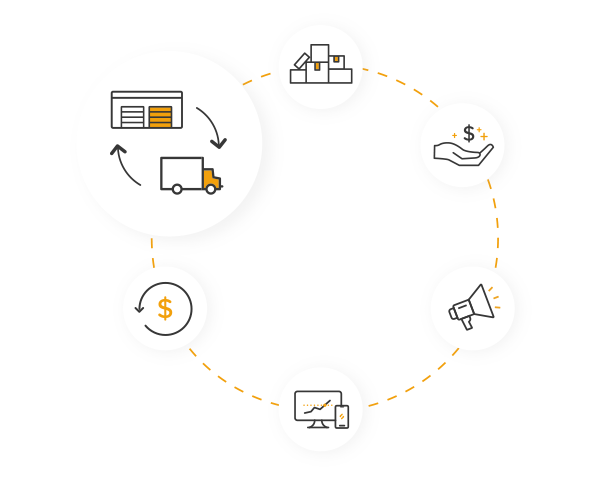Returns are a Tricky Challenge
When it comes to retail, returned items are a tricky problem to solve. For many brands, retailers, and 3PLs returns are often an afterthought. Rightfully so, the focus is commonly on driving sales, a great customer experience, and smooth outbound fulfillment processes. Yet data shows some level of returns are inevitable — and if not managed effectively they can be margin-crushers.
Why, exactly? Returns are inherently a high-touch process. There are several checkpoints to cover:
- First, is the returned item the correct item? If a high-end brand, is there a chance this is a knock-off version being returned?
- What is the condition of the item? Is it available for resale? If so, what resale channel will yield the highest financial recovery? Does the product need some basic value-added services to get it to a “new” status?
- Based on the condition, what is the best next destination for the item? How can you optimize where returned items go so more product goes back “on the shelf” at full price and much less goes to landfills?
Unfortunately, these processes can be subjective and can vary per item/SKU. Trying to manage returns manually can lead to labor-intensive, error-prone flows that result in mediocre results and losses for retailers.
Simply put, returns are a unique beast to solve. In fact, the latest research from Zebra Technologies shows that 47% of global warehouse operations leaders cited returns management as a top operational challenge in 2023 (Source).
As the market continues to change, savvy retailers and 3PLs are looking to crack the code and reduce the burn of returns. And one common question is: Should I use my warehouse management system for returns?
In this article we’ll take a look at the key differences between WMS vs. RMS and answer the question of which tool is best for retail returns.
The intent of a warehouse management system (WMS)
If looking to use a warehouse management system for returns, it is critical to understand the original intent of a WMS. The first WMS software originated around 1975, used by the retail company J.C. Penney. The purpose of the software was to manage warehouse operations — namely how much inventory is on hand at a particular node, and tracking the pick-pack-ship process for inventory sold to consumers.
Per the Gartner glossary, a WMS was built to “manage and intelligently execute the operations of a warehouse, distribution or fulfillment center. WMS applications offer capabilities such as receiving, put-away, stock locating, inventory management, cycle counting, task interleaving, wave planning, order allocation, order picking, replenishment, packing, shipping, labor management, yard management and automated materials handling equipment interfaces.”
And for over 50 years, warehouse management systems have been “forward-focused” on the outbound pick-pack-ship processes. However, most outbound processes are dealing with new products, with known (often pristine) conditions. While there are exceptions, they are few, and a WMS can seamlessly handle happy-path outbound fulfillment.
Shortcomings of using WMS for returns
When it comes to returns management, most warehouse management systems come up short.
Why? In general, WMS was built to solve outbound fulfillment for shippers. Yet, when it comes to the nuances of returns, WMSs lack the robust functionality that a purpose-built system has. A few challenges of using your WMS for returns management:
- WMS lacks specific functionality for returns – Detailed functionality like purpose-built returns receiving, test and grade, return reconciliation, robust dispositioning to 4+ resale channels, RTV management and more.
- WMS lacks automation for returns – Unless you customize your WMS, most systems lack workflow automation for the reverse logistics processes.
- Often require up to 2-3x labor to process with a WMS – Without a dedicated returns system, most operations end up simply throwing more labor at returns. At a time when labor is expensive and hard to find/keep, leveraging technology to decrease the dependency on additional labor is critical.
- Complex SOPs based on item/brand – Many retailers prefer to have unique processes depending on the returned item. This is very difficult to do without major customization to an out-of-the-box WMS.
- Impossible for associates to memorize unique processes – The introduction of brand-specific or SKU-specific SOPs puts a challenging onus on associates (who might speak English as a second language) to remember unique checklists and flows.
- Manual processes are more prone to error – When it comes to warehouse operations, technology helps mitigate human error that naturally evolves from sometimes tedious, repetitive, and seemingly subjective work.
- Requires extensive (and expensive) customization for returns – If you plan to use your WMS for returns, you will most likely have to customize an OOTB solution which is costly in both time and money. Additionally, software solutions that are highly customized often run into issues with upgrading that can prevent you from having the latest and greatest version, which is critical for a competitive SaaS solution.
- Lacks RMA creation capabilities – Because WMS is geared towards warehouse operations, they lack the ability to initiate RMAs, meaning you’ll still need another tool to be able to offer consumers a self-service returns solution on your ecommerce channel.
- Lacks tracking and visibility – While WMS is an irreplaceable tool within the four walls, it lacks visibility outside the four walls including return tracking and end-to-end visibility.
Introducing RMS: Returns Management System
While a WMS will always be a critical tool in the supply chain technology stack, more retailers and brands are moving towards purpose-built, best-in-breed solutions for returns.
As Gartner notes, “enterprises often purchase software from different vendors to obtain the best-of-breed offering for each application area.” As more organizations move to the best-of-breed approach to technology selection, RMS is the only purpose-built technology aimed at mitigating the impact of returns holistically, both to your customer and your bottom line.
What is an RMS?
A returns management system (RMS) is a technology platform that spans the entire returns lifecycle — from return initiation, return methods, shipping consolidation, dispositioning, and ultimately restock and resale. A true RMS will cover the end-to-end return journey:
- Offer return initiation via a front-end, customer-facing return portal, and nudge customers to exchange an item where applicable
- Facilitate multiple, convenient return methods i.e. drop-offs, pick-ups, lockers, mail back, BORIS, etc.
- Consolidate returns to reduce shipping costs back to the distribution center
- Return processing to receive, sort, test/grade, and disposition the product to its next-best destination, whether restock, resale, or recycle/refurb.
An RMS dovetails into the retail and commerce tech stack, integrating with other key systems including OMS, WMS, loyalty, fraud, and more.
RMS Benefits
360° returns insights
The core value of having a returns management system is the nature of understanding the full picture of returns. For example, by connecting customer-generated return reason codes to ultimate disposition status, merchandisers can modify purchasing decisions to avoid stocking problematic items.
Margin protection
An RMS with a robust returns portal will nudge shoppers to exchange an item, saving the sale and driving higher customer lifetime value.
Additionally, with comprehensive and automated dispositioning, retailers can increase financial recovery on returns by reselling items in higher-margin channels, reducing markdowns, and items sent to a landfill.
Better control of the returns experience
The returns experience can make or break retail. In fact, 95% of shoppers say a poor returns experience will make them less likely to shop from a brand again (Source). With a modern RMS, retailers can curate the ideal returns experience and even offer dynamic optionality based on shopper history like providing free returns to customers in your loyalty program, or offering instant exchanges (replacement ships immediately instead of waiting for returned merchandise) to surprise and delight shoppers.
Operational efficiencies to banish backlogs
Because returns are cumbersome to manage, many facilities experience a backlog of returns. To tackle the problem often requires more associates, driving up wage costs. With automated returns processing retailers and 3PLs can increase units per hour (UPH) by up to 2x— getting inventory into resalable channels faster with less headcount.
WMS vs. RMS Functionality Comparison
|
WMS |
RMS |
|
|---|---|---|
|
Inventory Control & Visibility |
SKU/UPC level tracking |
Unit level tracking (SKU/UPC – Condition – Return) |
|
Disposition |
User-generated disposition based on SOP |
System-generated disposition (via configurable rules engine) |
|
Receiving Workflow |
Desktop based Fairly inflexible |
Handheld System directed by configuration |
|
Exceptions |
Generally managed outside WMS (e.g. spreadsheet) |
Systematic tracking Purpose-built tools for resolving exceptions |
|
Returns-Specific Workflows |
None, unless system is customized |
VAS / Test and Grade Return to Vendor (RTV) functionality Directed Sorting (pre-putaway) |
|
Outbound Fulfillment |
Core capability for D2C, B2B fulfillment |
Systematic stock transfer to WMS Outbound fulfillment options for non-new inventory at SKU-condition level Integrated Recommerce and resale channels |
Pros & Cons of WMS vs. RMS for returns
Retail is never one size fits all. So when assessing which software tool to use to manage returns, it can be helpful to assess the pros and cons of each approach.
|
Option |
Pros |
Cons |
|
Use a workaround in your WMS |
|
|
|
Returns management system (RMS) |
|
|
Weighing Your Options
Retailers often resort to makeshift solutions, using either front-end technology or back-end software for returns processing. While these methods might offer initial cost savings and familiarity with tech providers, they lack the intentionality and comprehensive capabilities required for effective returns management.
Conclusion
In the quest to master returns management, the choice between WMS and RMS is clear. While WMS plays a pivotal role in fulfillment, RMS emerges as the superior solution for returns, offering tailored functionalities, automation, and comprehensive visibility. By embracing RMS, savvy retailers can transform returns from a logistical challenge into a strategic advantage, ultimately boosting customer satisfaction and profitability.
White Paper
The Returns Dilemma: How to Avoid the Cost-or-Revenue Trap
Balancing a great customer experience and mitigating the cost of returns is an evergreen conundrum for retailers. Download the Returns Dilemma to understand the latest research around returns (hint: it’s becoming a more critical challenge to solve) and how to approach returns with a holistic mindset.


Natalie Walkley
Vice President, MarketingNatalie has spent the last 15 years in marketing, with the last 7 years in supply chain technology for retailers and 3PLs. When she’s not geeking out about ecommerce news, she may be supporting brands through retail therapy. Natalie lives in the music capital of the world (Nashville, TN) with her husband and three children.
